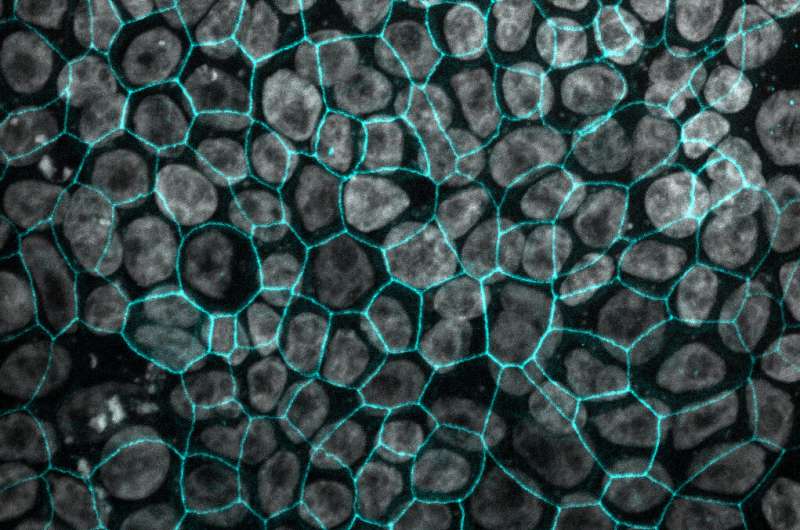This article has been reviewed according to Science X's editorial process and policies. Editors have highlighted the following attributes while ensuring the content's credibility:
fact-checked
peer-reviewed publication
trusted source
proofread
A new cell model for the human lung

Before new drugs can be tested in animal experiments and later in clinical trials, they must undergo a large number of laboratory tests. This involves the use of so-called cell lines, i.e., human or animal cells of a specific tissue that can be cultivated in the laboratory.
A team led by Prof Claus-Michael Lehr of the Helmholtz Institute for Pharmaceutical Research Saarland (HIPS) has now developed a novel human lung cell line that should enable much more accurate predictions of the behavior of active substances or dosage forms in humans than previous systems. The cell line could be used in, among other things, the development of drugs against SARS-CoV-2. The scientists published their results in the journal Advanced Science.
Since the 1950s, the ability to grow individual human cells in the laboratory has enabled researchers to investigate new drug candidates in the laboratory without having to conduct tests on animals or even humans. In many cases, the cultured cells are cancer cells. This offers the advantage that they are available in large numbers, since they can potentially multiply infinitely, but also leads to the fact that the cells differ significantly from "healthy" cells in many properties.
Since drug research involves the investigation of substances that are to be tested on animals and humans at a later stage of development, it is of great importance that the applied model systems are able to predict the behavior of a drug in a living organism as precisely as possible. This is where the work of Claus-Michael Lehr's team comes in. Lehr is head of the Department of Drug Delivery across Biological Barriers at HIPS and professor of biopharmacy and pharmaceutical technology at Saarland University. HIPS is a site of the Helmholtz Center for Infection Research in collaboration with Saarland University.
Claus-Michael Lehr's group has been working for many years on the development and application of biological model systems that mimic different human organs and thus reduce and ultimately replace studies on animals. The focus of the current research work is the human lung.
Based on the lung epithelial cell line "hAELVi" already published in 2016, the cell line "Arlo" has now been developed as part of the work of Ph.D. student Patrick Carius. "Arlo originated from a single hAELVi cell, which we obtained by so-called single cell printing," explains Dr. Nicole Schneider-Daum, senior scientist from Lehr's department. "This means that all cells are derived from a single hAELVi progenitor cell and are therefore genetically identical."
In the laboratory, Arlo forms a very dense cell layer, which is extremely similar to the human epithelium in the deep lung. In addition, the cell line provides highly reproducible results because it is a more uniform cell population than its predecessor. Both cell lines were artificially immortalized, i.e., they proliferate as often as desired, but without exhibiting undesirable cancer-like characteristics.
The potential application of Arlo is versatile: On the one hand, the cell line offers a platform for testing new drugs or nano-carriers, which are to be administered as an aerosol. In addition, Arlo can also be used in infection models for bacterial or viral diseases. "This combination potentially makes our development a very valuable tool for studying infections with SARS-CoV-2 and agents to combat it," says Lehr.
"Our cell lines should mimic the situation in human lungs so well that we can reduce the number of animal experiments needed and eventually even replace them completely. The predecessor cell line hAELVi has been commercially available for several years and is already being used in over 50 laboratories worldwide. This makes us quite proud and shows that we have been able to make a valuable contribution to the international research landscape with our research.
"We are convinced that Arlo, which is also commercially available as of now, will be similarly well received by the community in the coming years and can also make a valuable contribution to new developments and insights."
In the study, which involved researchers from Saarland University and Frankfurt University Hospital as well as physicians from SHG Kliniken Völklingen, the team comprehensively characterized its new cell line and has already used it in a SARS-CoV-2 infection model. Arlo will also be used in more complex model systems in the future, in which the cell line will be combined with other cell types. This should make it possible to obtain results that even better represent the actual situation in the living organism.
More information: Patrick Carius et al, A Monoclonal Human Alveolar Epithelial Cell Line ("Arlo") with Pronounced Barrier Function for Studying Drug Permeability and Viral Infections, Advanced Science (2023). DOI: 10.1002/advs.202207301




















